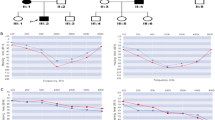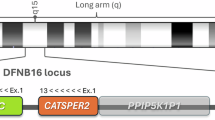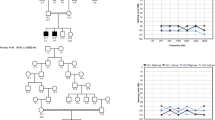Abstract
Autosomal dominant nonsyndromic hearing loss (ADNSHL/DFNA) is a highly genetically heterogeneous disorder. Hitherto only about 30 ADNSHL-causing genes have been identified and many unknown genes remain to be discovered. In this research, genome-wide linkage analysis mapped the disease locus to a 4.3 Mb region on chromosome 19q13 in SY-026, a five-generation nonconsanguineous Chinese family affected by late-onset and progressive ADNSHL. This linkage region showed partial overlap with the previously reported DFNA4. Simultaneously, probands were analyzed using exome capture followed by next-generation sequencing. Encouragingly, a heterozygous missense mutation, c.505G>A (p.G169R) in exon 3 of the CEACAM16 gene (carcinoembryonic antigen-related cell adhesion molecule 16), was identified via this combined strategy. Sanger sequencing verified that the mutation co-segregated with hearing loss in the family and that it was not present in 200 unrelated control subjects with matched ancestry. This is the second report in the literature of a family with ADNSHL caused by CEACAM16 mutation. Immunofluorescence staining and western blots also prove CEACAM16 to be a secreted protein. Furthermore, our studies in transfected HEK293T cells show that the secretion efficacy of the mutant CEACAM16 is much lower than that of the wild type, suggesting a deleterious effect of the sequence variant.
Similar content being viewed by others
Log in or create a free account to read this content
Gain free access to this article, as well as selected content from this journal and more on nature.com
or
References
Kalatzis, V. & Petit, C. The fundamental and medical impacts of recent progress in research on hereditary hearing loss. Hum. Mol. Genet. 7, 1589–1597 (1998).
Marazita, M. L ., Ploughman, L. M ., Rawlings, B ., Remington, E ., Arnos, K. S. & Nance, W. E. Genetic epidemiological studies of early-onset deafness in the U.S. school-age population. Am. J. Med. Genet. 46, 486–491 (1993).
Reardon, W. Genetics of deafness: clinical aspects. Br. J. Hosp. Med. 47, 507–511 (1992).
Van Camp, G ., Willems, P. J. & Smith, R. J. Nonsyndromic hearing impairment: unparalleled heterogeneity. Am. J. Hum. Genet. 60, 758–764 (1997).
Petersen, M. B. Non-syndromic autosomal-dominant deafness. Clin. Genet. 62, 1–13 (2002).
Hilgert, N ., Smith, R. J. & Van Camp, G. Forty-six genes causing nonsyndromic hearing impairment: which ones should be analyzed in DNA diagnostics? Mut. Res 681, 189–196 (2009).
Ng, S. B ., Buckingham, K. J ., Lee, C ., Bigham, A. W ., Tabor, H. K. & Dent, K. M. et al. Exome sequencing identifies the cause of a mendelian disorder. Nat. Genet. 42, 30–35 (2010).
Zhu, M. & Zhao, S. Candidate gene identification approach: progress and challenges. Int. J. Biol. Sci. 3, 420–427 (2007).
Bamshad, M. J ., Ng, S. B ., Bigham, A. W ., Tabor, H. K ., Emond, M. J. & Nickerson, D. A. et al. Exome sequencing as a tool for Mendelian disease gene discovery. Nat. Rev. Genet. 12, 745–755 (2011).
Clark, J. G. Uses and abuses of hearing loss classification. ASHA 23, 493–500 (1981).
Abecasis, G. R ., Cherny, S. S ., Cookson, W. O. & Cardon, L. R. Merlin—rapid analysis of dense genetic maps using sparse gene flow trees. Nat. Genet. 30, 97–101 (2002).
Lathrop, G. M ., Lalouel, J. M ., Julier, C. & Ott, J. Strategies for multilocus linkage analysis in humans. Proc. Natl Acad. Sci. USA 81, 3443–3446 (1984).
Li, H. & Durbin, R. Fast and accurate short read alignment with Burrows-Wheeler transform. Bioinformatics 25, 1754–1760 (2009).
Li, R ., Li, Y ., Kristiansen, K. & Wang, J. SOAP: short oligonucleotide alignment program. Bioinformatics 24, 713–714 (2008).
Li, R ., Li, Y ., Fang, X ., Yang, H ., Wang, J. & Kristiansen, K. et al. SNP detection for massively parallel whole-genome resequencing. Genome Res. 19, 1124–1132 (2009).
DePristo, M. A ., Banks, E ., Poplin, R ., Garimella, K. V ., Maguire, J. R. & Hartl, C et al. A framework for variation discovery and genotyping using next-generation DNA sequencing data. Nat. Genet. 43, 491–498 (2011).
Adzhubei, I. A ., Schmidt, S ., Peshkin, L ., Ramensky, V. E ., Gerasimova, A. & Bork, P. et al. A method and server for predicting damaging missense mutations. Nat. Methods 7, 248–249 (2010).
Morton, N. E. Sequential tests for the detection of linkage. Am. J. Hum. Genet. 7, 277–318 (1955).
Zheng, J ., Miller, K. K ., Yang, T ., Hildebrand, M. S ., Shearer, A. E. & DeLuca, A. P. et al. Carcinoembryonic antigen-related cell adhesion molecule 16 interacts with alpha-tectorin and is mutated in autosomal dominant hearing loss (DFNA4). Proc. Natl Acad. Sci. USA 108, 4218–4223 (2011).
Chen, A. H ., Ni, L ., Fukushima, K ., Marietta, J ., O'Neill, M. & Coucke, P. et al. Linkage of a gene for dominant non-syndromic deafness to chromosome 19. Hum. Mol. Genet. 4, 1073–1076 (1995).
Donaudy, F ., Snoeckx, R ., Pfister, M ., Zenner, H. P ., Blin, N. & Di Stazio, M. et al. Nonmuscle myosin heavy-chain gene MYH14 is expressed in cochlea and mutated in patients affected by autosomal dominant hearing impairment (DFNA4). Am J. Hum. Genet. 74, 770–776 (2004).
Mirghomizadeh, F ., Bardtke, B ., Devoto, M ., Pfister, M ., Oeken, J. & Konig, E. et al. Second family with hearing impairment linked to 19q13 and refined DFNA4 localisation. Eur. J. Hum. Genet. 10, 95–99 (2002).
Pusch, C. M ., Meyer, B ., Kupka, S ., Smith, R. J ., Lalwani, A. K. & Zenner, H. P. et al. Refinement of the DFNA4 locus to a 1.44 Mb region in 19q13.33. J. Mol. Med. (Berl) 82, 398–402 (2004).
Yang, T ., Pfister, M ., Blin, N ., Zenner, H. P ., Pusch, C. M. & Smith, R. J. Genetic heterogeneity of deafness phenotypes linked to DFNA4. Am. J. Med. Genet. A. 139, 9–12 (2005).
Zong, L ., Lu, C ., Zhao, Y ., Li, Q ., Han, D. & Yang, W. et al. Clue to a new deafness gene: a large Chinese nonsyndromic hearing loss family linked to DFNA4. J. Genet. Genomics 39, 653–657 (2012).
Kammerer, R ., Ruttiger, L ., Riesenberg, R ., Schauble, C ., Krupar, R. & Kamp, A. et al. Loss of mammal-specific tectorial membrane component carcinoembryonic antigen cell adhesion molecule 16 (CEACAM16) leads to hearing impairment at low and high frequencies. J. Biol. Chem. 287, 21584–21598 (2012).
Benchimol, S ., Fuks, A ., Jothy, S ., Beauchemin, N ., Shirota, K. & Stanners, C. P. Carcinoembryonic antigen, a human tumor marker, functions as an intercellular adhesion molecule. Cell 57, 327–334 (1989).
Boulton, I. C. & Gray-Owen, S. D. Neisserial binding to CEACAM1 arrests the activation and proliferation of CD4+ T lymphocytes. Nat. Immunol. 3, 229–236 (2002).
Eidelman, F. J ., Fuks, A ., DeMarte, L ., Taheri, M. & Stanners, C. P. Human carcinoembryonic antigen, an intercellular adhesion molecule, blocks fusion and differentiation of rat myoblasts. J. Cell Biol. 123, 467–475 (1993).
Ergun, S ., Kilik, N ., Ziegeler, G ., Hansen, A ., Nollau, P. & Gotze, J. et al. CEA-related cell adhesion molecule 1: a potent angiogenic factor and a major effector of vascular endothelial growth factor. Mol. Cell 5, 311–320 (2000).
Muenzner, P ., Bachmann, V ., Zimmermann, W ., Hentschel, J. & Hauck, C. R. Human-restricted bacterial pathogens block shedding of epithelial cells by stimulating integrin activation. Science 329, 1197–1201 (2010).
Sarantis, H. & Gray-Owen, S. D. Defining the roles of human carcinoembryonic antigen-related cellular adhesion molecules during neutrophil responses to Neisseria gonorrhoeae. Infect. Immun. 80, 345–358 (2012).
Schmitter, T ., Agerer, F ., Peterson, L ., Munzner, P. & Hauck, C. R. Granulocyte CEACAM3 is a phagocytic receptor of the innate immune system that mediates recognition and elimination of human-specific pathogens. J. Exp. Med. 199, 35–46 (2004).
Zimmer, R. & Thomas, P. Mutations in the carcinoembryonic antigen gene in colorectal cancer patients: implications on liver metastasis. Cancer Res. 61, 2822–2826 (2001).
Zebhauser, R ., Kammerer, R ., Eisenried, A ., McLellan, A ., Moore, T. & Zimmermann, W. Identification of a novel group of evolutionarily conserved members within the rapidly diverging murine Cea family. Genomics 86, 566–580 (2005).
Kuespert, K ., Pils, S. & Hauck, C. R. CEACAMs: their role in physiology and pathophysiology. Curr. Opin. Cell Biol. 18, 565–571 (2006).
Balciuniene, J ., Dahl, N ., Borg, E ., Samuelsson, E ., Koisti, M. J. & Pettersson, U. et al. Evidence for digenic inheritance of nonsyndromic hereditary hearing loss in a Swedish family. Am. J. Hum. Genet. 63, 786–793 (1998).
Meyer, N. C ., Alasti, F ., Nishimura, C. J ., Imanirad, P ., Kahrizi, K. & Riazalhosseini, Y. et al. Identification of three novel TECTA mutations in Iranian families with autosomal recessive nonsyndromic hearing impairment at the DFNB21 locus. Am. J. Med. Genet. A. 143A, 1623–1629 (2007).
Mustapha, M ., Weil, D ., Chardenoux, S ., Elias, S ., El-Zir, E. & Beckmann, J. S. et al. An alpha-tectorin gene defect causes a newly identified autosomal recessive form of sensorineural pre-lingual non-syndromic deafness, DFNB21. Hum. Mol. Genet. 8, 409–412 (1999).
Cheatham, M. A ., Goodyear, R. J ., Homma, K ., Legan, P. K ., Korchagina, J. & Naskar, S. et al. Loss of the tectorial membrane protein CEACAM16 enhances spontaneous, stimulus-frequency, and transiently evoked otoacoustic emissions. J. Neurosci. 34, 10325–10338 (2014).
Borders, C. L. Jr., Broadwater, J. A ., Bekeny, P. A ., Salmon, J. E ., Lee, A. S. & Eldridge, A. M. et al. A structural role for arginine in proteins: multiple hydrogen bonds to backbone carbonyl oxygens. Protein Sci. 3, 541–548 (1994).
Voges, M ., Bachmann, V ., Naujoks, J ., Kopp, K. & Hauck, C. R. Extracellular IgC2 constant domains of CEACAMs mediate PI3K sensitivity during uptake of pathogens. PloS One 7, e39908 (2012).
Acknowledgements
We gratefully thank all the subjects in this study for their collaboration. We appreciate professor Wolfgang Zimmermann and his lab (Tumor Immunology Laboratory, LIFE Center, University Hospital of Munich, Ludwig-Maximilians-University Munich, Germany) for providing the pRc/CMV-hCEACAM16 plasmid. We thank Dr Denise Yan and Dr Robert Cunningham Gerring of the University of Miami, Miller School of Medicine for comments on the manuscript. This study was partly supported by National Basic Research Program of China (also called 973 Program) (2014CB541702); by National Nature Science Foundation of China (81170923, 81470705 and 81300833); by Special Scientific Research Fund for Public Welfare Industry of the Ministry of Health in China (201302001); by Natural Science Foundation of Hunan Province, China (14JJ7009 and 13JJ4023) and by the National Institutes of Health grants R01DC005575 and R01DC012115 to XZL.
Author information
Authors and Affiliations
Corresponding authors
Ethics declarations
Competing interests
The authors declare no conflict of interest.
Additional information
Supplementary Information accompanies the paper on Journal of Human Genetics website
Supplementary information
Rights and permissions
About this article
Cite this article
Wang, H., Wang, X., He, C. et al. Exome sequencing identifies a novel CEACAM16 mutation associated with autosomal dominant nonsyndromic hearing loss DFNA4B in a Chinese family. J Hum Genet 60, 119–126 (2015). https://doi.org/10.1038/jhg.2014.114
Received:
Revised:
Accepted:
Published:
Issue date:
DOI: https://doi.org/10.1038/jhg.2014.114
This article is cited by
-
Further evidence for loss-of-function mutations in the CEACAM16 gene causing nonsyndromic autosomal recessive hearing loss in humans
Journal of Human Genetics (2019)
-
A novel mutation in the SMPX gene associated with X-linked nonsyndromic sensorineural hearing loss in a Chinese family
Journal of Human Genetics (2018)
-
ELMOD3, a novel causative gene, associated with human autosomal dominant nonsyndromic and progressive hearing loss
Human Genetics (2018)



